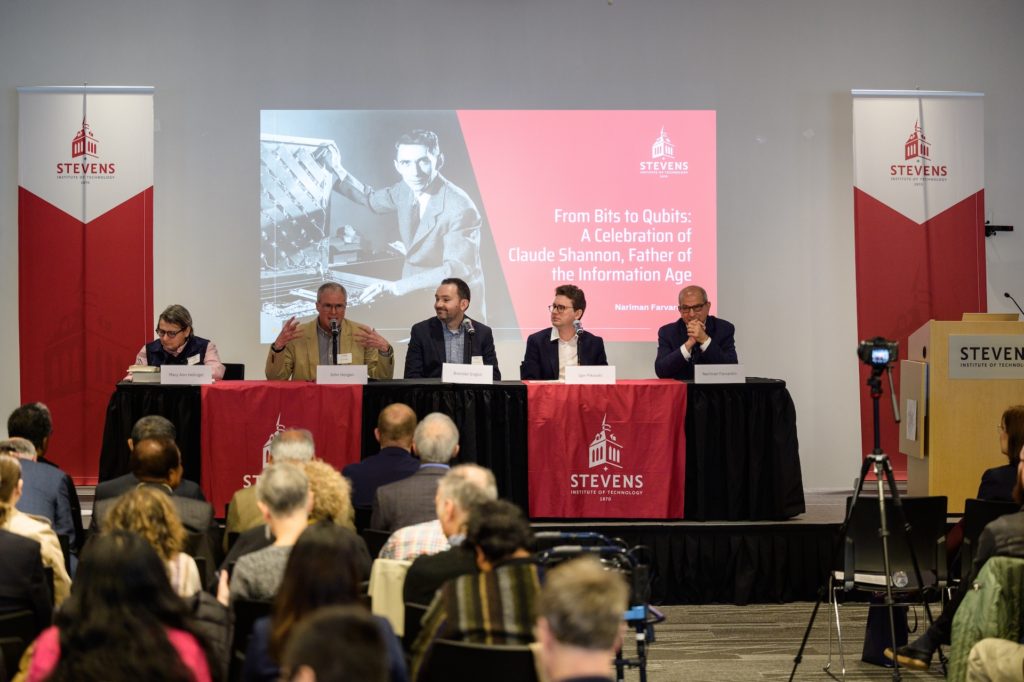Claude Shannon, the “Father of the Information Age,” is one of the most influential mathematicians and computer scientists of the past 100 years, a symbol of innovation and discovery who embodies the Stevens ethos. To honor Shannon and the legacy of his work, President Nariman Farvardin hosted an event in partnership with the Institute of Electrical and Electronics Engineers (IEEE) History Center to explore and celebrate the accomplishments of Shannon in a lecture titled “From Bits to Qubits: A celebration of Claude Shannon, Father of the Information Age.” To learn more, The Stute attended the lecture and spoke with President Farvardin.
Claude Shannon (1916-2001) showed signs of intellectual greatness from an early age. He graduated with two undergraduate degrees only at 20, then pursued his master’s degree, which he completed in only one year. His thesis, A Symbolic Analysis of Relay and Switching Circuits, was one of the first and most influential papers that used Boolean algebra (in simplified terms, using “yes” and “no” as a form of logic) to introduce ideas that serve as the basis for binary code and the foundation for all computers. The paper is noted by many as one of, if not the most crucial, thesis to come out of a master’s degree. Shannon then pursued a doctorate by studying the impact of information theory on genetics and biology, revolutionizing another field of science, and then never worked with biology again. Going into his professional career, Shannon continued his work, making innumerable contributions to early computer science, cryptology, and electrical engineering. He was one of the first engineers to work on what would become artificial intelligence.
President Farvardin’s lecture series began at 9:30 a.m. with a light breakfast before introductions by Vice President for University Relations and Chief of Staff Beth McGrath. The event’s first speaker was Dr. Mary Ann Hellrigel, the Institutional Historian and Archivist of the IEEE History Center, who explained what IEEE is and how Shannon contributed to it.
Next, President Farvardin gave the keynote address. Opening his lecture with an anecdote about how he sat next to Shannon as a young professor at a conference in 1985, President Farvardin examined Shannon’s work in information theory and how he was responsible for beginning that field. However, President Farvardin also explored the more human side of Shannon, like his passion for juggling, unicycle riding, and inventing, the last of which included making machines to indulge his engineering interests like a juggling machine, Rubik’s Cube solver, and an early version of what would become a chess-playing computer.
The last segment of the event was a panel discussion moderated by the director of the Center of Science Writing, Professor John Horgan. On the panel, Dr. Hellrigel and President Farvardin spoke with Professor Brendan Englot, the Institute for Artificial Intelligence director, and Professor Igor Pikovski, a Presidential Fellow with a background in quantum physics. The panel examined Shannon’s influence outside pure information theory but in other disciplines like physics and artificial intelligence.
Following the presentation and before a luncheon, The Stute spoke with President Farvardin to get a more personal view of the event. When asked why Shannon is important, Farvardin explained that Shannon is one of his foremost intellectual influences. To this end, when asked why it is essential to learn about Shannon, President Farvardin referred to the panel and his lecture, highlighting how, with so much influence of Shannon in many different fields, it is essential to learn the history and foundations of these disciplines to be successful in them.
Shannon was an exceptional mathematician and computer scientist who left an indelible mark on our world and its technology. President Farvardin’s lecture celebrated Shannon’s legacy and explored his contributions to various disciplines. To end the conversation, President Farvardin underscored the importance of research, a theme also discussed in the lecture. Research, he explained, allows for an unparalleled experience of learning and growth where young minds, some of whom might become the next Shannon, will develop.
